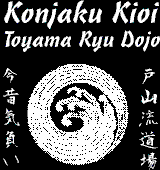 |
Toyama Ryu Batto Do Konjaku Kioi Dojo (Ancient and Modern Fighting Spirit Dojo) |
5980 66th St N Suite M St Petersburg FL 33709 Email: info@toyama-ryu.com Phone: 727-329-9679 |
|
Home
|
Fundamentals (Kihon) 基本Kihon (Fundamentals) are reflected in all aspects of swordsmanship. Poor kihon makes poor kata, kumitachi, kenjustsu, and tameshigiri. Polishing the fundamentals will improve every aspect of our art and needs to be constantly done. At every rank these must be constantly polished to make progress. We must be kigamawaru 気が回る(attentive to small details). Beware the trap of thinking that you have mastered kihon, it will mark the end of your learning.
Wearing a Katana (Taitō) 帯刀The katana goes between the first and second layer of the obi. The left thumb is used to open up the obi. The katana is slipped into and obi and goes above one of the front straps of the hakama. This is the strap that was tied in the back. The ha (edge) should be up. The sageo is looped up under the hakama straps on the right side. The loose end then goes through the first loop forming a second loop. The second loop is pulled to tighten the knot. It is important to face forward and keep alert when putting the katana and tying the sageo. The student should be mentally preparing for class and looking down would invite attack.
Wearing Daishō (Taidaishō) 帯大小How the katana and wakizashi are worn varies depending on the style of swordsmanship practiced. The following defines the proper way they should be worn in the Konjaku Kioi Toyama Ryu Dojo. The obi should be long enough to wrap around three times. Both the wakizashi and katana are put in the obi on the left side.
|
Copyright © 2006 by Konjaku Kioi Toyama Ryu Dojo, All rights reserved.
Samurai Swords
Iaito (Practice Swords)
Shinken (Cutting Swords)
Wakizashi (Short Swords)
Tanto (Daggers)
Japanese Weapons
Maintenance
Uniforms
Sharpening
Sword Repair
Martial Arts
Dictionary Your Name in Japanese
Dojo Stories
Tatami Targets
